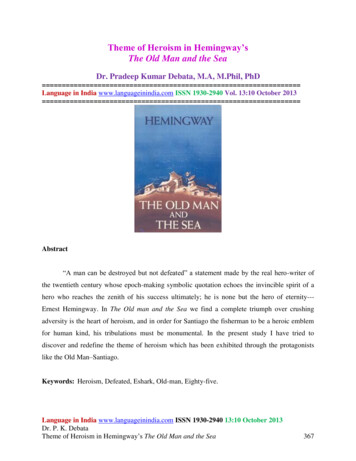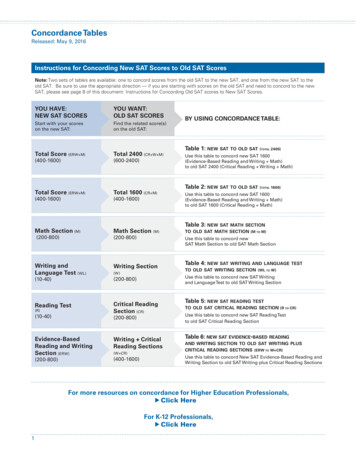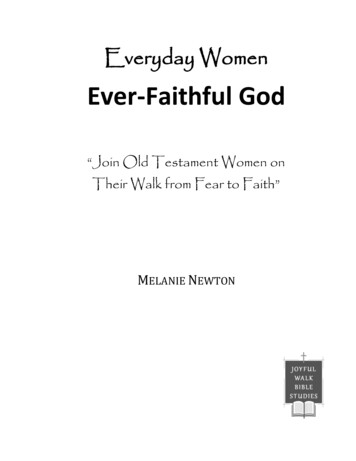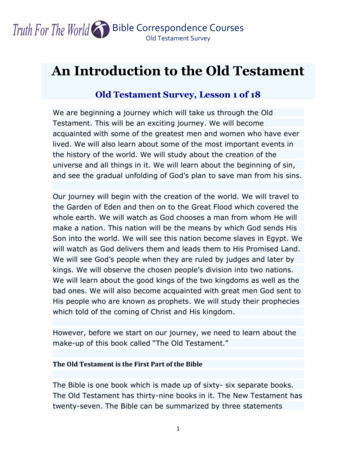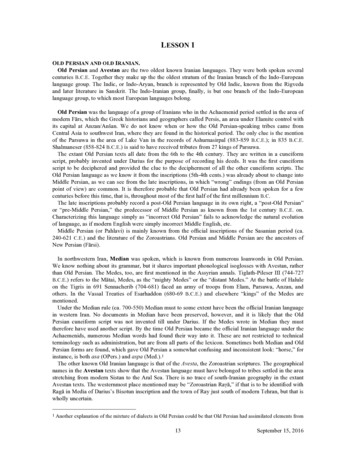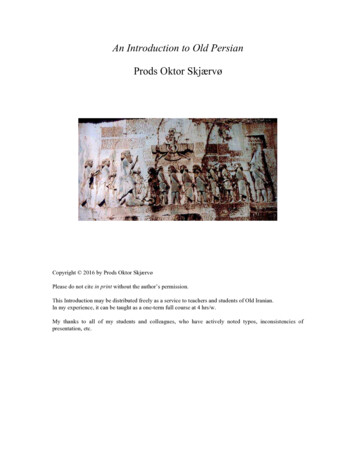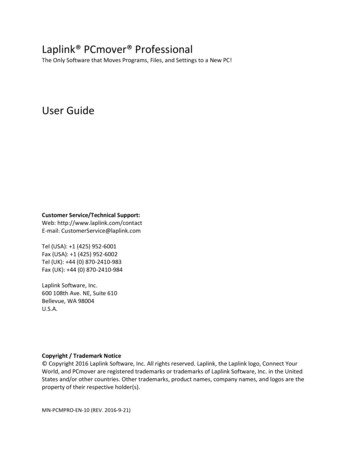
Transcription
A study of the Tabernacle1A Study of the Old Testament TabernacleOne of the most enlightening portions of the Bible is that which concerns theJewish Tabernacle. The Tabernacle illustrates in a great, historic object lesson that God’splan of redemption has been the same throughout the ages. Different times and ageshave varied in their spiritual perception however, the central truths of God’sredemptive process have never changed. To an age that knew little about God, theTabernacle showed the way to communion with God and foreshadowed the coming ofthe great high priest, the Lord Jesus Christ.The Tabernacle of the Old Testament was the worshiping place of the Hebrewpeople from the time of their wandering in the wilderness [around the 13th or 15th centuryB.C.] to the early days of the Hebrew kings [about 1,000 B.C.]. Later the figures and typesof the Tabernacle were also built into the Temple in Jerusalem; they were the shadow ofwhich Christ was the reality! It was as if a great light were shining from the future,casting the shadow of Christ over a thousand yeas ahead of His time.The fact that the Tabernacle typified the redemptive process of Christ is wellestablished in the Scriptures. The book of Hebrews states concerning Christ that “wehave such an high priest, who is set on the right hand of the throne of the Majesty in the heavens,a minister of the sanctuary, and of the true tabernacle, which the Lord pitched, and not man”(Hebrews 8:1-2). Hebrews also states that the Tabernacle prefigured that which wasrevealed in its fullness in Christ Jesus.
A study of the Tabernacle2These lessons are in search of truthsconcerning Christ Jesus found in the TabernacleCareful reading of the book of Hebrews in the New Testament –- especiallychapters 8 & 9 –- will show the relationship between the Old Testament saints and theNew Testament Christians. Overlooking the valuable lessons of the Tabernacle, onemisses a great opportunity to fully understand and appreciate the redemptive work ofJesus Christ. The student of Scripture must understand that the principles of salvationhave never changed. God’s plan of salvation was established “before the foundation of theworld” and those who chose to be followers of God have observed its principles sincetime began –- whether it was Abel offering his “excellent sacrifice” at the beginning ofhistory; the Israelites offering their sacrifices at the Tabernacle in the wilderness; or youand I accepting by faith the propitiatory work of Jesus Christ today. God’s plan ofsalvation for mankind has always been the same.The Tabernacle performed a particularly special role in revealing God’sprinciples and plan of salvation, especially to the Jews. Too often the student ofScripture forgets that Christianity has its roots in Judaism. Jesus was a Jew, and all butone of the writers of the New Testament was a Jew. This makes it all the moreimportant that we understand the relationship between Judaism –- [the Tabernaclesacrifices] –- and Christianity –- [the sacrifice of Jesus Christ]. The laws and history givenin the Pentateuch –- [the1st 5 books of the Bible] –- are the platform upon which the restof the Bible stands. Misunderstanding in this area can lead to false teachings aboutGod’s character and His plan of salvation.Although the differences between worshipping God at the Tabernacle under theOld Testament Covenant and worshipping Him under the New Covenant areprofound, the principles are identical. How else can one understand the Bible when itspeaks of Christ’s death as from the foundation of the world (Revelation 13:8)? Also, inRomans 3:25-26,Speaking of Jesus Christ [See verse 24} Paul writes, “WhomGod hath set forth to be a propitiation through faith in his blood, todeclare his righteousness for the remission of sins that are past,through the forbearance of God; To declare, I say, at this time hisrighteousness: that he might be just, and the justifier of him whichbelieveth in Jesus.”We see the efficacy –- [or effectiveness and value] –- of Christ’s death for OldTestament saints as well those of the New Testament. The same is expressed inHebrews 9:15, “And for this cause He is the Mediator of the New Testament, that by means ofdeath, for the redemption of the transgressions that were under the first testament –- [OldTestament] –- they which are called might receive the promise of eternal inheritance.”For this reason, I believe the salvation experiences of the Old Testament saintswere identical to ours today! Who can say they didn’t experience, at least, inwardly, thesame shameful awareness of their sinfulness, the same contrite heart, and repugnance at
A study of the Tabernacle3what is unholy and a dependence of God’s sacrifice for the atonement of their sins?Keeping this in mind, we can see there need not be any difference in God’s dealing withmankind, only the revealed stage of God’s plan of redemption has changed.The writer of the book of Hebrews, speaking of the sacrifices of the Tabernacle,states, “And the Holy Spirit uses all this to point out to us that under the old system –[Revealed in the Old Testament] – the common people could not go into the Holy of Holies aslong as the outer room and the entire system it represents were still in use. This has animportant lesson for us today. For under the old system, gifts and sacrifices were offered, butthese failed to cleanse the hearts of the people who brought them. For the old system dealt onlywith certain rituals -- what foods to eat and drink, rules for washing themselves, and rules aboutthis and that. The people had to keep these rules to tide them over until Christ came with God'snew and better way” (Hebrews 9:8-10 – From the Living Bible).Even though God has used various means to express His plan of redemption, therequirement for man to appropriate it hasn’t changed. It has always been by faith in thepropitiation of Christ’s accomplishments. The substantial rituals of the Mosaic lawswith its observance at the Tabernacle never saved a soul! It only served to portray thereality of God’s reconciliation to His people and therefore served as a tangible way inwhich they could express their faith in the sacrifice God provided. Though theceremonial aspects made their expression of faith more physical, it did not lessen therelationship they could have with God, for if the heart was not right and there was not arecognition of the divine intention, it availed them nothing.While worship at the Tabernacle was central to the spiritual well being of theIsraelites –- (and only as we understand that God dealt with them as He does with us) –will we begin to see the tremendous importance of the Tabernacle.Perhaps another reason few see the importance of the Tabernacle has to do withthe general belief that it was used for only forty years when, in fact, it was used for 647years! In addition, when the Tabernacle was no longer in use, Israel came to Jerusalemto worship God in Solomon’s Temple, which continued the exact same means ofapproaching God. Therefore, the nation of Israel from its birth to the death of Christ, aperiod of 1,700 years, approached God with the same system initiated originally withthe Tabernacle in the wilderness. The fact that the Israelites used the Tabernacle and itssystem of worship for hundreds of years should certainly indicate its importance.Present day Christians may still glean something from a study of the Tabernacle, as thewriter of Hebrews so wonderfully reveals.Another factor that emphasized the Tabernacle’s importance was its location atthe center of the camp and the position of the Levites, who camped nearby to guardagainst unlawful approach. The other tribes also camped around the Tabernacle but at adistance. The Tabernacle was also at the center of the nation during marches (Numbers10:17).
A study of the Tabernacle4The Camp of Israel – (Numbers 2:1 through 3:39)NCamp of ubenSimeonCamp of ReubenS The events surrounding the giving of the pattern for the Tabernacle also point toits importance. The pattern was given to Moses on his sixth ascent to Mount Sinai whenGod gave the law. Therefore, with the giving of a greater revelation of God’s law, there wasalso a giving of a greater revelation of God’s reconciliation with His people. This is atremendously important fact that is often overlooked. It was also an important occasionfor mankind; for God, in giving His moral standard to the Israelites, also gave them tothe world. “What nation is there so great that hath statues and judgments so righteous as allthese Jews” (Deuteronomy 4:8). These laws pertained to every aspect of their lives,guiding them in their infancy as a nation, setting them apart as a peculiar [treasured]nation, even to this day. It has taken other nations, apart from the Biblical revelation,many hundreds of years to understand the need of laws similar to those God gave theIsraelites.The Bible records how great these laws are, but, just as importantly, it reveals theresult of neglecting them – which is God’s divine punishment. The seesaw relationshipIsrael had with God was always as a result of their obedience or disobedience to theselaws.Listen to Hebrews 3:8-19, “And since Christ is so much superior, the Holy Spirit warnsus to listen to Him, to be careful to hear His voice today and not let our hearts become set againstHim, as the people of Israel did. They steeled themselves against His love and complained againstHim in the desert while He was testing them. But God was patient with them forty years, thoughthey tried his patience sorely; He kept right on doing His mighty miracles for them to see. ‘But,’God says, I was very angry with them, for their hearts were always looking somewhere elseinstead of up to Me, and they never found the paths I wanted them to follow.’ Then God, full ofthis anger against them, bound Himself with an oath that He would never let them come to Hisplace of rest. Beware then of your own hearts, dear brothers, lest you find that they, too, are eviland unbelieving and are leading you away from the living God. Speak to each other about thesethings every day while there is still time so that none of you will become hardened against God,
A study of the Tabernacle5being blinded by the glamour of sin. For if we are faithful to the end, trusting God just as we didwhen we first became Christians, we will share in all that belongs to Christ. But now is the time.Never forget the warning, Today if you hear God's voice speaking to you, do not harden yourhearts against Him, as the people of Israel did when they rebelled against Him in the desert.’ Andwho were those people I speak of, who heard God's voice speaking to them but then rebelledagainst Him? They were the ones who came out of Egypt with Moses their leader. And who wasit who made God angry for all those forty years? These same people who sinned and as a resultdied in the wilderness. And to whom was God speaking when He swore with an oath that theycould never go into the land He had promised His people? He was speaking to all those whodisobeyed Him. And why couldn't they go in? Because they didn't trust Him” (Living Bible).God’s justice demands punishment for disobedience. When penalty is notinflicted, it encourages rebellion. However, God desired to extend mercy to theIsraelites. This had to be undertaken wisely. As good as laws are, once broken, they canonly bring condemnation and demands the infliction of a penalty. Paul said, “If there hadbeen a law given which could have given life, verily righteousness should have been by the law”(Galatians 3:21). The principle involved here is that once a law is broken it can neverjustify, only demand that its penalty be inflicted upon the lawbreaker. This does notmake the law bad at all. What law can justify once it is broken? The problem thatconfronted God was how He could extend mercy to the Israelites and, at the same time,uphold His law. To do this without consideration for His law would encouragerebellion.Therefore, it is not difficult to realize the great importance of the Tabernaclebecause it was through the Tabernacle that God demonstrated, in shadow, how Hewould extend His mercy without abolishing His law. Through the Tabernacle, theIsraelites had the Gospel preached to them: “For unto us was the Gospel preached, as well asunto them” (Hebrews 4:2). This is the most important lesson of the Tabernacle, and onethat should continually be kept in view. Failure to see this central theme has possiblyled to much confusion of God’s Word. The Gospel preached to them by object lessons –(through the Tabernacle; its priesthood; rituals; offerings and furniture) –- was basedupon the same principles found in the New Testament Gospel.If the Tabernacle is to be a true type of the Gospel then the similarity betweenthem must be real! God didn’t have two Gospels; rather, when Christ came He revealedthe Gospel that was concealed in the “types and shadow” of the Tabernacle. This in noway moderated the salvation of the Israelites, for the law never justified them; rather,they were justified by faith just as we are presently. The only thing lacking in theGospel preached through the Tabernacle was that Christ had not yet died as the Lambslain from the foundation of the world.
A study of the Tabernacle6ExodusThe book of Exodus, the book that gives us the Tabernacle, logically follows thebook of Genesis –- because Genesis tells the story of man’s failure. It begins with thesublime expression, “In the beginning God ” and closes with the symbolic words, “In acoffin in Egypt.” The book of Genesis is he story of man going from a perfect creation tosin and death. However, the book of Genesis gives the hope of a promised Redeemer.Thus, the story of Genesis!Then, follows the book of Exodus, the book of Redemption! It covers 40 chapters,13 of which have to do entirely with the Tabernacle in the wilderness, and the priestswho were to minister therein.However, before any mention is made of the Tabernacle, the story of redemptionis written in language that cannot be mistaken. The opening chapter of Exodus tells thestory of slavery –- a picture of the sinner’s bondage to Satan and sin. The children ofIsrael were given a deliverer from the bondage of Egypt in the person of Moses. (We areoffered the only Savior from bondage to Satan in the Person of the Lord Jesus Christ.)The story of the birth of Moses and his call from God to deliver Israel is told inthe early chapters of Exodus. Then, follows the record of God’s righteous judgmentupon those who turned an unheeding ear toward God, the only Deliverer. The tenplagues upon the Egyptians are a picture of judgment on all who refuse to accept God’ssalvation in Christ Jesus. The last, of which was associated with the first Passover inIsrael, is a type of Christ the Paschal Lamb.Exodus is a continued story of God’s redemption. Immediately after thePassover, Israel was delivered from the hosts of the Egyptians at the Red Sea, anotherbeautiful picture of God’s redemption for all who will put their trust in His BelovedSon.From the Red Sea on, the story in Exodus is one of Israel’s wilderness wanderingfor forty years as God took care of His children.In order to show Israel how helpless they were in their own strength, their needof the promised Redeemer, and that they could never measure up to God’s perfectstandard of holiness apart from this promised Redeemer, God gave them the TenCommandments and the detailed explanation of their meaning.
A study of the Tabernacle7This is the story of Exodus up to the beginning with chapter 25 where we havethe description of God giving the pattern for the Tabernacle.Men attempt to cut portions from God’s Word and to present amutilated shorter Bible. All Scripture is inspired and, yet, do we not commitvirtually the same sin through neglect of some portions of God’s Word? Thebare enumeration of materials, quantities and dimensions relating to theTabernacle may be regarded by the casual reader as “uninteresting” and“unimportant,” until one considers that the Holy Spirit has borne record that“All Scripture is God-breathed and is profitable to all” (2 Timothy3:16).The account of the Tabernacle begins in Exodus 25, as Moses receives instructionsfrom God during his 40 days on Mount Sinai. It is important to note that God gaveMoses two important things on the mountain –- the Ten Commandments and detailedinstructions for the building of the Tabernacle.The Israelites, in bondage 430 years (Exodus 12:40 & Galatians 3:17), was nowdelivered from the rule of Pharaoh. Since that time Moses had been their leader, he, inturn, received his instructions from God. In Exodus 18:5-6, God proposed to give themlaws. God was now their King. This was the beginning of the Theocracy. Naturally twoevents followed:1. A code of laws was made (Exodus, chapters 20 through 24)2. A dwelling place for the King was build (Exodus, chapters 25 through 40)The very first mention of the Tabernacle is in Exodus 15:17. This was God’sdwelling place among men. The word “Tabernacle” means, “dwelling place.”From the completion of the Tabernacle until the present time God has never beenwithout a dwelling place on earth. After the Tabernacle, the Temple was God’s house,and, then its glory had departed, God came to earth in the Person of His Son, JesusChrist (John 1:14 & Colossians 2:9).When Jesus left this earth, He sent the Comforter, the Holy Spirit, and He dwellsin the hearts of individual believers today (1 Corinthians 3:16-17). And, so the wholebody of believers forms the true Church, the habitation of God in this present ChurchAge (Ephesians 2:21-22 & Exodus 25:8 with Matthew 18:20).
A study of the TabernacleMoses, at God’s command, went up in the mount, and for six days waited forGod’s voice. He was forty days getting the pattern of the Tabernacle, as God wasshowing him into the heavenlies, and telling him exactly how the pattern of theTabernacle should be built.When Moses came down from the mount, after getting the pattern for theTabernacle, his face shone! Her had beheld God’s glory and had seen the trueTabernacle in the heavenlies (Acts 7:44).Note the striking similarity between theHeavenly Tabernacle and the earthly one – onthe previous page.A study of the Tabernacle is, withoutquestion, one of the most enlightening studiesin the Word of God. The importance of theTabernacle cannot be missed because of the factthat God devoted so much of His Word toreveal its construction, its meaning, itspriesthood, and worship instructions to thisTabernacle. There are 13 chapters in Exodus –18 in Leviticus –- 13 in Numbers –- and 4 inHebrews dealing with the Tabernacle. This isremarkable when one considers that only twochapters in the Bible are devoted to describingthe creation of the entire universe.Not only the amount of information inthe Bible about the Tabernacle points to itssignificance, but, when we begin to realize thecost of its construction that God ordered theIsraelites to assemble, the implication of lessonsimplicated in the Tabernacle are remarkable.Without doubt the Tabernacle was the most8
A study of the Tabernacle9expensive and beautiful portable house of worship ever built, but more than that, therehas never been such a costly prefabricated structure of any kind constructed. More over,constructed according to the pattern God gave to Moses in the Mount, it was amazinglysimple to dismantle and reassemble.When God told Moses to build the Tabernacle in the wilderness according to aspecific pattern, He said to construct it “according to all that I show thee, after the pattern ofthe Tabernacle, and the pattern of all the instruments (furniture) thereof, even so shall ye makeit” (Exodus 25:9).God inspired the writer of the book of Hebrews in the New Testament to explainthe spiritual significance of the Tabernacle. Hebrews 8:1-2 states, “Now the things whichwe are saying –- [that is, the things written in the book of Hebrews] –- is this: We have an HighPriest such as has been described –- [described previously in the book of Hebrews] –- Who hastaken His seat at the right hand of God’s majestic throne in heaven: where He ministers in thenSanctuary in the true Tabernacle, built by the Lord and not by human hands.”Moses’ writings especially the book of Exodus that deals with spiritualredemption, points to Christ. This is obvious from the words of the Christ Himself, whostated in Luke 24:26, “Did not the Messiah have to suffer these things and then enter Hisglory.” Then verse 27 He goes on to state, “And beginning with Moses and all the Prophets,He explained to them what was said in all the Scriptures concerning Himself.”Jesus said in John 5:39, “You diligently study the Scriptures because you think that bythem you possess eternal life. These are the Scriptures that testify about Me.” And in verse 46,He said, “If you believed Moses, you would believe Me, for he wrote about Me.”The Tabernacle symbolically foretold of Christ and His death for the forgivenessof sin. God painted a portrait of Christ through the Tabernacle, and some 1,500 years asJohn says, “the Word was made flesh and dwelt among us” (John 1:14). Interestingly, theGreek word translated as “dwelt” here is actually the same word as “tabernacle,” oractually, “tabernacled.” Through the Tabernacle God foreshadowed many beautifullessons about Christ that will greatly enhance our appreciation for the Savior.The Purpose of the TabernacleThe purpose of the Tabernacle was threefold: First, it was to give the Israelites amuch needed physical symbol of God’s presence in their midst. The natural tendency ofthe Israelites, even after all God had done for them, was to turn from God (Exodus 32:16). In Numbers 17:7-8 the Tabernacle is twice called “the Tabernacle of witness.” Thus, theTabernacle was to be a physical witness of the PRESENCE of God among His people, asthe Lord said in Exodus 28:8, “that I may dwell among them.” It was to be a sanctuary, aplace set apart, for God to dwell among His people.The second purpose of the Tabernacle was to foreshadow the One in whim all thesymbolism and sacrifices would be fulfilled. Hebrews 9:22-26 explains the spiritualpurpose of the Tabernacle, when it states,
A study of the Tabernacle10“The law requires that nearly everything be cleansed with blood, andwithout the shedding of blood there is no forgiveness. It was necessary,then, for the copies of the heavenly things to be purified with thesesacrifices, but the heavenly things themselves with better sacrifice thenthere. For Christ did not enter a man-made sanctuary that was only acopy of the true one; He entered heaven itself, now to appear for us inGod’s presence. Nor did He enter heaven to offer Himself again andagain, the way the high priest enters the Most Holy Place every year withblood that is not his own. Then Christ would have had to suffer manytimes since the creation of the world. But now He has appeared once forall at the end of the ages to do away with sin by the sacrifice of Himself.”The third purpose of the Tabernacle was to represent a divine means throughwhich sinful humanity could approach a holy God. It was to reveal how the brokenrelationship with God caused by sin could be restored, ultimately through the SupremeHigh Priest, Jesus Christ.The Tabernacle was to be a portable structure so that it could be moved along withthe Israelites as they traveled to the Promised Land. Today the dwelling place of God isstill portable and is still intended to be a witness of God’s presence in the world and ofthe way of redemption.2 Corinthians 6:16-18 states,“And what agreement hath the temple of God with idols? for ye arethe temple of the living God; as God hath said, I will dwell inthem, and walk in them; and I will be their God, and they shall bemy people. Wherefore come out from among them, and be yeseparate, saith the Lord, and touch not the unclean thing; and Iwill receive you, And will be a Father unto you, and ye shall be mysons and daughters,’ saith the Lord Almighty.”And, Acts 1:8 states, “You will received power when the Holy Spirit comes on you; andYOU will be My witnesses.”After Israel leftEgypt,-- Mosesreceived clearinstructions fromGod for the buildingof the Tabernacle –revealed in the bookof Exodus.(1) Exodus,chapters 20-24 givethe code of God’slaws, (2) Exodus,chapters 25-40 give
A study of the Tabernacle11instructions for the dwelling place of God.Before beginning a detailed study of the Tabernacle, I like for us to take a “bird’seye” view of this tent in the wilderness. The Tabernacle was the worshiping place of theHebrew people from the time of their wandering in the wilderness to the early days ofthe Hebrew kings.GOD, the ORIGINATOR and ARCHITECTGod entrusted the actual building to Moses, however, He as the Superintendentof construction.Not only did God give the plans for the Tabernacle, He had a “model” in Heavento go by from which He gave His blue prints – (See Hebrews 9:23).The Tabernaclewas a “portable,moveable, cartable”tent, enclosed by ahanging fine twinedlinen wall (or fence)that surrounded theTabernacle, leaving alarge open space,referred to as, “thecourt yard.”THE TABERNACLEGod gave Moses very detailed instructions as to how to construct the Tabernaclein the wilderness. Before we journey through the gate to the innermost part of theTabernacle proper, let’s look at the fence and gate.Every aspect of the Tabernacle offers deep insights into the spiritual truthsthat are ultimately revealed throughout the New Testament. These variouselements of the Tabernacle demonstrate such truths such as: the separationcaused by sin; the penalty for sin; confession of sin; redemption from sin; trueworship; why we need a high priest; prayer; sanctification; and many otherwonderful Scriptural truths. There is not any part of the Tabernacle that is notconnected with at least one spiritual truth.Surrounding the Tabernacle was aperfectly rectangular court twice as long as itwas wide. This court was enclosed by a fencehigh enough to keep anyone from entering orfrom looking over into the court.The material used in the construction ofthe fence around the court consisted of finetwined linen (Exodus 27:9), held up by 60 pillars.
A study of the Tabernacle12The finest, white linen was hung on beautiful pillars. There were 20 pillars each on thenorth and south (Exodus 27:9-11) and 10 pillars each on the east and west (verses 12-13).The pillars were made of acacia wood. Exodus 27:17-18 describes the materials use inmaking these pillars seen in the diagram to the right.The pillars wee kept at equal distance apart by silver connecting rods attachednear the top of each pillar and were held upright with rods tied from the silver hooks tobrass tent stakes driven into the ground.This open courtyard, surrounding the Tabernacle was 75 feet by 150 feet. It was 7and ½ feet high, supported by these 60 brass pillars, having hooks of silver. The gate ofthe court, in the center of the East side, was 30 feet wide and was wrought withneedlework of blue, purple, and scarlet of fine twined linen.Within the court fence one can find revealed many deep spiritual truths, some ofwhich were not revealed unto the writing of the New Testament. This courtyard fenceclearly and distinctly created a barrier or a separation between God and man.This fence, separating those on the outside from God’s presence on the inside,certainly sheds light on Isaiah 59:2, that teaches, “Your iniquities have separated you fromyour God; your sins have hidden His face from you, so that He will not hear you.”The fact that the fence that surrounded the Tabernacle was made of shiningwhite fine linen also represents “the righteous acts of the saints,” according to Revelation19:8 that states, “ for the fine linen is the righteousness of the saints.”The fine white linen fence taught that God was encircled with righteousness, andwhen approached on God’s terms and conditions He could make humanity righteousas well.This fine twined linen fence that encircled the court spoke eloquently of thesinlessness and righteousness of God and of what He requires of those who wouldcome into His holy presence then, as well as now. Instead of meeting God’srequirements and doing what He demands in order to obtain righteousness, so manytoday –- like the Jews in Paul’s day –- made a very serious mistake.Paul writes, “Brethren, my heart's desire and prayer to God forIsrael is, that they might be saved. For I bear them record that theyhave a zeal of God, but not according to knowledge. For they beingignorant of God's righteousness, and going about to establish theirown righteousness, have not submitted themselves unto therighteousness of God” (Romans 10:1-3).The GateThe gate through the fence, giving entry to the Tabernacle, was on the east andwas the only entrance into the court. It was suspended on four pillars, that were exactlylike the other pillars of the fence. The gate was in the center of the east fence, with tencubits –- (15 feet) –- of court fence on either side.
A study of the Tabernacle13The fence that encircled the court yard was shining white with no color, but thegate was quite different – Exodus 27:16 states, “And for the gate of the court shall be anhanging of twenty cubits [30 feet] of blue, and purple, and scarlet, and fine twined linen,wrought with needlework: and their pillars shall be four, and their sockets four.”The gate with its beautiful colors stood out from the rest of the fence, drawingattention to itself as the one and only entrance into God’s presence. The Israelites knewthat only way into the presence of God was through the beautiful gate on the east.Entering the courtyar
A study of the Tabernacle 1 A Study of the Old Testament Tabernacle One of the most enlightening portions of the Bible is that which concerns the Jewish Tabernacle. The Tabernacle illustrates in a great, historic object lesson that God’s plan of redemption has be


